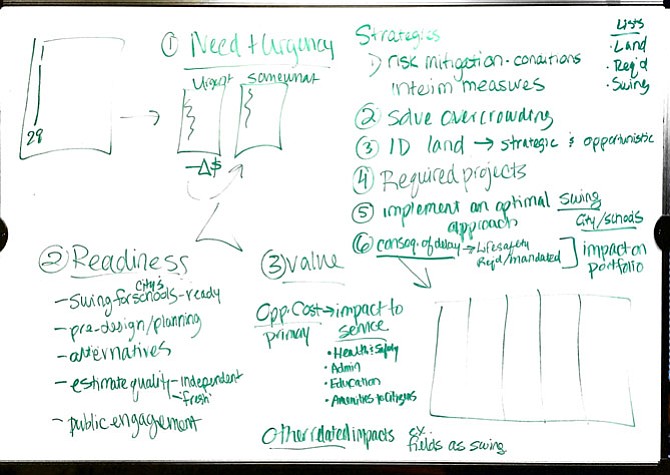An ad hoc joint city-school task force collected notes from a first dry run through its draft capital project prioritization schema.
The Ad Hoc Joint City-Schools Facility Investment Task Force waded into the nitty-gritty of prioritizing and considering alternatives to capital projects at its third meeting on Thursday, Sept. 7.
City Council charged the Task Force to recommend how to execute city and school projects to close a $106 million funding gap through FY27.
Discussion unfolded as the Task Force walked through a prioritization process. After refining, this process will provide a framework through which to develop recommendations. So far it includes three steps: (1) demonstration of need and relative urgency; (2) demonstration of project readiness; and (3) demonstration of value to Alexandria. These steps comprise a total of 13 draft criteria identified previously, plus a few more that the Task Force suggested for inclusion. A criterion that received much discussion is the consequence of delay — in terms both of impact on the capacity to deliver core government services, and also of tradeoffs in community benefits or amenities. Another example criterion is a capital project’s impact on the operating budget.
The notional dry run illustrated a systematic approach to spreading projects, currently frontloaded in the near-term, more evenly across the timeframe of funding availability and projected school enrollment growth. Proposed school projects really are frontloaded, resulting in a $70.4 million funding gap (66 percent of the total) in the first three years of the Task Force’s purview. And the city and school system expect pre-k and elementary enrollment to increase steadily, by nearly one percent per year on average, through FY27. The Task Force would work to stack the best mix of urgent, ready and value-added projects to the left on the timeline, and to bump other projects to the right.
In particular, the Task Force discussed how to achieve what consultant Beth Penfield dubbed the “optimal swing [space] approach.” Swing space is a temporary facility for students while permanent schools are constructed. The city administration will also need swing space while its facilities, including city hall, are renovated.
“In my looking at this, [optimal swing space] is the log jam for unlocking the entire CIP [Capital Improvement Program],” said Task Force member Dwight Dunton.
Revisiting an idea raised at an earlier subcommittee meeting, he suggested that a possible alternative to swing space is building a new school on the recreation field behind George Mason Elementary School. This could prevent the need to convert the Nannie J. Lee Memorial Recreation Center into a temporary school, at a projected cost of $42 million under the current plan.
“I think there are some of those opportunities. But, for whatever reason” — resident opposition to losing open space, in the case of George Mason’s field — “those may not have been embedded in the current list of recommendations … And I think we need to dig in and find where those opportunities are and say, ‘We understand the schools made a good decision in the context of the schools’ needs. However, in the context of the entire city, we’re suggesting to close George Mason field to build that [new] school while the kids remain in the [current] school’ — for instance, as an example.”
Others echoed his sentiments.
“We have developed schools without using swing space,” said Task Force chair Lynn Hampton. She suggested weighing the cost of doing construction at a school site while it’s still in use “against the moving kids across town and the cost of swing space. We have to look at those alternatives. … There are some schools that are needed in the outlying areas. There’s other needs in the outlying areas. Does it make sense to build something and use it as swing space, and then when it comes around that all swing space [needs are] gone, you can use it for a school, or use it for housing, or use it for some other purpose?”
Task Force member Amy Liu. said: “I do want to register quite directly … my discomfort of putting criteria and staging and sequencing on a set of projects, as if we are endorsing the projects as they are. … I want to raise a lot of questions about the actual projects. I know that they have gone through a process. I don’t want to question the wisdom that has informed those things. But I also … don’t know that there’s enough public debate on some of these issues.”
Specifically, she questioned “the consolidation of all the pre-school in one building. … I know that most households, particularly low-income people, think of pre-school as a neighborhood asset … So I don’t want to just sign off on that.” She also questioned the Minnie Howard campus “as the automatic second site for the expansion of high school. … There’s a lot of embedded assumptions in that decision … These larger community conversations need to happen — there seems to be a disconnect or some major fundamental priors before we can put forward these recommendations.”
Task Force member Elliot Branch said, “There’s this whole set of implicit assumptions that drive you to a solution and a project definition that have not been exposed to any level of public discussion. So I’d like to understand what it is. It’s like, you only get half credit in math class if you don’t show your work.”
Members concurred that they should not stray too far from their task to sequence existing projects. At the same time, their ultimate goal is not just to provide one finite project list, but also to “give the city methods so that … it’s not necessary to have the Task Force ever again,” said Hampton.

